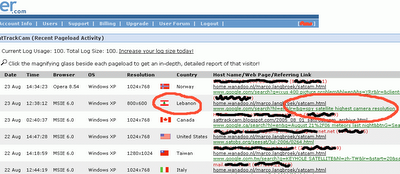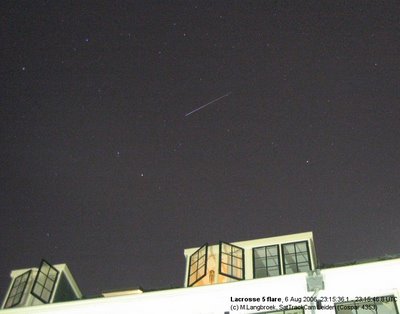After many days with heavy rainshowers, it cleared yesterday evening.
I did a short observation run: cut short alas by the return of clouds just before an IGS 1B zenith pass. I did manage to get data on Lacrosse 2 (91-017A),and observed two short bright glints by two Keyholes, USA 186 (05-042A) and USA 129 (96-072A). Lacrosse 2 appearred some 0.1s early.
2005-042A glinted to mag. 0 during less than a second at about 20:01:25 ± 5s UTC. 1996-072A did the same to mag 0 at 20:22:17 ± 3s UTC.
I captured both flares/glints on photograph, but in both cases only the very brief glints show up (almost star-like) and not the fainter rest of the trail, hence no useful positions could be derived from the images and they are not even worth posting here.
THE SECRET SPIES IN THE SKY - Imagery, Data Analysis, and Discussions relating to Military Space
SatTrackCam Leiden (Cospar 4353) is a satellite tracking station located at Leiden, the Netherlands. The tracking focus is on classified objects - i.e. "spy satellites". With a camera, accurate positional measurements on satellites of interest are obtained in order to determine their orbits. Orbital behaviour is analysed.
This blog analyses Missile tests too.
Sunday 27 August 2006
Thursday 24 August 2006
20% off on all Weapons of Mass Destruction!!!!
Okay, after Hezbollah visited my website yesterday, they seemed to have given a call to their benefactors to check things out. Because today I found these IP entries in my webstats:

Maybe I ought to start including some Google ads for Weapons of Mass Destruction on my webpage, it might perhaps bring me some revenues... :-p
PS: and welcome back, Cuba!

(Click image to enlarge)
Maybe I ought to start including some Google ads for Weapons of Mass Destruction on my webpage, it might perhaps bring me some revenues... :-p
PS: and welcome back, Cuba!
Wednesday 23 August 2006
Feind hort mit!
Uuhmmm, yeah....: if you suddenly see this kind of IP with this kind of search engine keywords appear in the webstats of your satelite tracking camera webpage, that gives you reasons to think, isn't it?

Maybe also the opportunity to say hi to the reader from Cuba that frequently visits... (come to think of it: he/she seems to be gone since Fidel is in hospital...)
* starts to scan the skies for black unmarked helicopters... *

(click image to enlarge)
Maybe also the opportunity to say hi to the reader from Cuba that frequently visits... (come to think of it: he/she seems to be gone since Fidel is in hospital...)
* starts to scan the skies for black unmarked helicopters... *
Saturday 12 August 2006
Slow Lacrosse 5 flare (belated post)
Due to circumstances, a quite belated report.
I observed a beautifull pass of Lacrosse 5 (2005-016A, #28646) one week ago, August 6-7. It was very bright, and showed a slow magnitude zero flare at (Aug 06) 23:15:25 ± 10s UTC.
For the part of the pass that I could observe (roughly from 30 deg altitude NW, where I first picked it up, to 40 deg altitude NE where it moved behind the building) it did not do its 'disappearance trick' this time.
I obtained 3 trail photographs during the pass. The positions indicate Lacrosse 5 was approoxmately 0.4 seconds late
A photograph of the very bright trail fading gradually some seconds after the brightness peak (photograph 2 in the series) can be seen here:

I observed a beautifull pass of Lacrosse 5 (2005-016A, #28646) one week ago, August 6-7. It was very bright, and showed a slow magnitude zero flare at (Aug 06) 23:15:25 ± 10s UTC.
For the part of the pass that I could observe (roughly from 30 deg altitude NW, where I first picked it up, to 40 deg altitude NE where it moved behind the building) it did not do its 'disappearance trick' this time.
I obtained 3 trail photographs during the pass. The positions indicate Lacrosse 5 was approoxmately 0.4 seconds late
A photograph of the very bright trail fading gradually some seconds after the brightness peak (photograph 2 in the series) can be seen here:

(Click on image for larger version)
Thursday 3 August 2006
Difficult Lacrosse 5 flare (?) observation
Tried to observe the 01:11:48 UTC predicted Lacrosse 5 (2005-016A, #28646) flare last night predicted for my location by Phillip Masding.
Observing conditions were very bad, as I had to watch the sat through broken cloud cover. I cannot 100% positively say I saw it flare in the sense of seing it rise and fall in brightness: all I can say is that it was very bright at the flare time, being about mag.-1 (when I first picked it up lower in the sky at 01:10:00 UTC, it was about mag. +1.5).
Photograph below (01:11:46.1 - 01:11:56.8 UTC). The photograph gives you a good idea of the difficult observing conditions.
It is overcast with heavy rainshowers here at the moment, so I am affraid this evenings possible flare is lost for me.

Observing conditions were very bad, as I had to watch the sat through broken cloud cover. I cannot 100% positively say I saw it flare in the sense of seing it rise and fall in brightness: all I can say is that it was very bright at the flare time, being about mag.-1 (when I first picked it up lower in the sky at 01:10:00 UTC, it was about mag. +1.5).
Photograph below (01:11:46.1 - 01:11:56.8 UTC). The photograph gives you a good idea of the difficult observing conditions.
It is overcast with heavy rainshowers here at the moment, so I am affraid this evenings possible flare is lost for me.

(click image for larger picture)
Tuesday 1 August 2006
Lacrosse 5: now you see it, now you don't....
Phillip Masding had predicted a possible Lacrosse 5 (2005-016A) flare for me for last night at 21:50:22 UTC:
Flare Results for Flight Mode YVV Panel Angle 33°
12. SAR MA 2.97104043228698 at 31/07/2006 21:51:22 Alt=74.2391395227923
However: it did not flare, but disappeared again instead....
I picked Lacrosse 5 up at about 21:50:00 UTC near Bootes/CrB. It was mag. +2.5 brightening to +2.0 in the next half minute or so.
Somewhere around 21:50:45 I started to look at my clock to trigger the camera countdown at 21:51:07 UTC. When I looked up again at 21:51:09 or so, it already was gone. It did not re-appear.
The photograph (21:51:18.1 to 21:51:28.8 UTC) shows no trail at all, meaning that at that time it must have been fainter than +3.5. Would it have been as bright as it was a 21:50:00 to 21:50:45 it would be visible on the image, and certainly if it subsequently would have flared.
There was some thin cirrus in the sky, but the area where it should have flared was clear and faint stars are visible on the image.
Flare Results for Flight Mode YVV Panel Angle 33°
12. SAR MA 2.97104043228698 at 31/07/2006 21:51:22 Alt=74.2391395227923
However: it did not flare, but disappeared again instead....
I picked Lacrosse 5 up at about 21:50:00 UTC near Bootes/CrB. It was mag. +2.5 brightening to +2.0 in the next half minute or so.
Somewhere around 21:50:45 I started to look at my clock to trigger the camera countdown at 21:51:07 UTC. When I looked up again at 21:51:09 or so, it already was gone. It did not re-appear.
The photograph (21:51:18.1 to 21:51:28.8 UTC) shows no trail at all, meaning that at that time it must have been fainter than +3.5. Would it have been as bright as it was a 21:50:00 to 21:50:45 it would be visible on the image, and certainly if it subsequently would have flared.
There was some thin cirrus in the sky, but the area where it should have flared was clear and faint stars are visible on the image.
Subscribe to:
Posts (Atom)